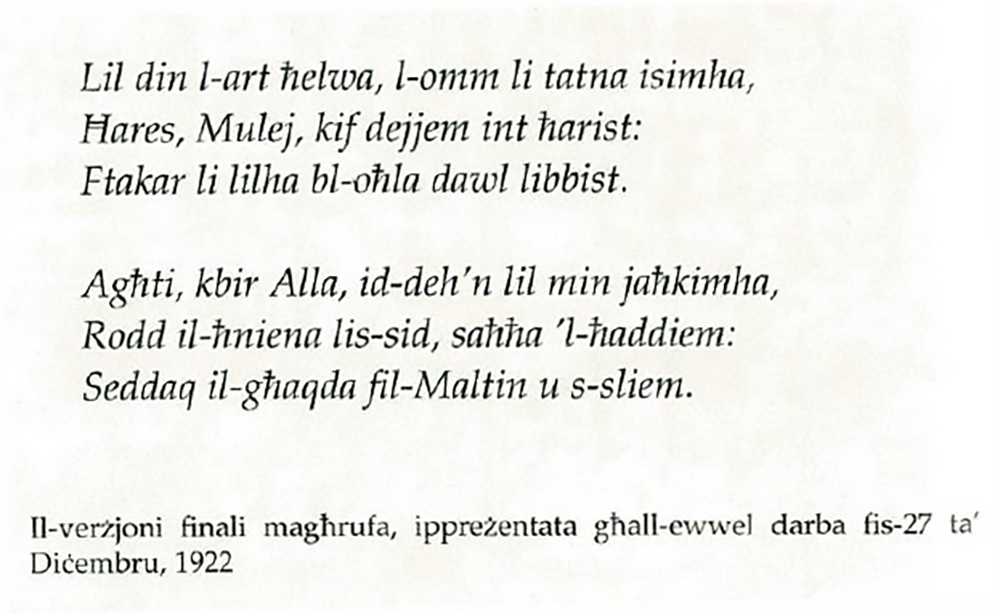The Maltese language, or Il-Lingwa Maltija, is a singular linguistic marvel: the only Semitic language in the European Union and the only one written in the Latin alphabet. With roots in Arabic and influences from Italian, Sicilian, and English, Maltese is a unique blend that reflects Malta's history as a cultural crossroads. Today, it thrives as a symbol of national pride and identity, but its journey has been anything but straightforward.
 The Lyrics of the Maltese National Anthem as they were presented for the first time on the 27th of December 1922.
The Lyrics of the Maltese National Anthem as they were presented for the first time on the 27th of December 1922.
Early origins and formation of Maltese
The Maltese language originated in the 9th century, following the Arab conquest of Malta. The new settlers brought a dialect of Arabic known as Siculo-Arabic, which was a variant of ancient Arabic spoken on the nearby island of Sicily, Italy, and over time it blended with the languages of neighboring regions, particularly Sicilian and Italian. By the Middle Ages, this evolving vernacular had developed into something distinct from other Arabic dialects, with a vocabulary enriched by Italian and Sicilian words.
Maltese continued to grow as a language of daily life, yet it existed outside of formal education and governance, especially with the arrival of foreign rulers. The local population spoke Maltese, while the ruling classes, from the medieval Normans to the Knights of St. John, used Italian or Latin in official settings. Italian remained an official language of Malta up until 1934 due to political instability. This division created a cultural and linguistic separation between rulers and the Maltese people, often sidelining the Maltese language.
Maltese language under colonial rule
With the arrival of the British in 1800, a new chapter began in the story of Maltese. English replaced Italian as the language of administration and education, and the British attempted to spread their language as a unifying force. This led to a 19th-century debate known as The Language Question, a fierce conflict between advocates of Italian and English as Malta’s official language. While English gained traction, Maltese was often disregarded as a “vernacular” or informal language, unsuited for government or formal education.
Despite attempts to suppress it, the Maltese language persisted among the population. Figures such as Mikiel Anton Vassalli, known as the “Father of the Maltese Language,” championed its development, producing early dictionaries and grammar books. This set the stage for Maltese to be standardized and used in literature, proving it was more than just a spoken dialect. The people’s commitment to their language made Maltese a symbol of cultural resilience, despite the forces attempting to replace it.
Official recognition and national pride
In 1934, a major turning point arrived: Maltese was finally recognized as the official language of Malta, alongside English. This decision marked a historic moment, elevating Maltese from a “home language” to a language of government, education, and media. This official recognition solidified the language as a core part of Malta’s national identity, reclaiming it as a symbol of independence and pride.
When Malta gained independence from Britain in 1964, Maltese further cemented its role as a unifying national language. By the time Malta joined the European Union in 2004, Maltese had achieved international recognition as an official EU language, marking a historic milestone for a language with fewer than 500,000 speakers.
The modern status and legacy of Maltese
Today, Maltese is spoken by nearly the entire Maltese population and remains a vital part of daily life, culture, and education. It is the language of government, the arts, and public life, while English is widely used as a second language, particularly in business and higher education. As a result, Malta is a bilingual society, where both languages coexist in harmony yet have different roles.
However, there are challenges. English continues to influence Maltese, especially among younger generations who frequently code-switch between the two languages. Additionally, English is dominant in many fields, leading some to worry about Maltese’s future as a language of high culture and academia. Yet the Maltese government and educational institutions are committed to preserving and promoting the language, encouraging its use in all facets of life.
The Future of the Maltese language
The future of Maltese is a delicate balance of preservation and adaptation. In an increasingly globalized world, it faces pressures from England, but it also benefits from the protections afforded by its EU status and local dedication to its survival. Technology, media, and digital resources are being harnessed to engage young Maltese speakers, creating new ways to interact with and celebrate their language.
Maltese stands as a resilient cultural pillar, having withstood centuries of foreign rule, suppression, and adaptation. Today, it embodies the Maltese people’s spirit, bridging their past with the modern world. While its future holds uncertainties, one thing is clear: Maltese will continue to be a source of pride, identity, and connection for the people of Malta as they carry their language forward into the world.















